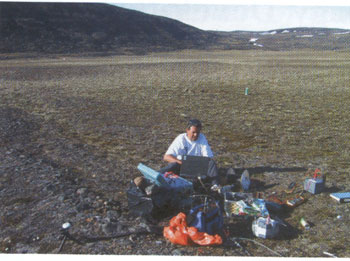| 2003 |

|
YEAR BOOK |
Dublin Institute for Advanced Studies
|
Lighting up the Lithosphere
|

The method is simple and elegant in concept, although making it work well under field conditions and solving the inverse problem for complex three-dimensional structures is another matter. The natural magnetic field at the Earth's surface is constantly fluctuating on a wide range of time scales due to ionospheric whistler waves, geomagnetic pulsations, etc. These fluctuating fields induce currents in any conducting materials buried in the crust, which in turn produce secondary electromagnetic fields at the surface. By accurately sampling these time varying surface electric and magnetic fields over a sufficiently long period of time and sufficiently large area, it is possible, using computer inversion techniques, to reconstruct the conductivity structure of the underlying crust. The method is particularly sensitive to salt solutions, graphite layers and sulphide ore bodies; all tracers of potentially important economic resources as well as scientifically interesting indicators of prior tectonism in otherwise inaccessible regions.
Professor Jones brings an ambitious research programme to DIAS which will involve field work in Ireland, in Europe, and on other continents. His first project, partially funded by DeBeers and by the US National Science Foundation, will start in the Autumn in Southern Africa, where he will be studying the region which is home to the world's major diamond mines. He is currently seeking Post Doctoral Fellows and Postgraduate Students with skills in geophysics, physics and mathematics (inverse theory) to work with him on this and future projects.
Contact: Professor Alan Jones;
The School of Cosmic Physics, Dublin Institute for Advanced Studies,
5 Merrion Square, Dublin 2;
E-Mail; [email protected]